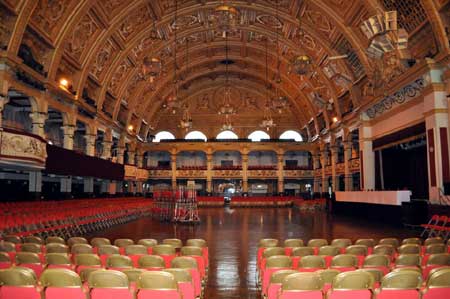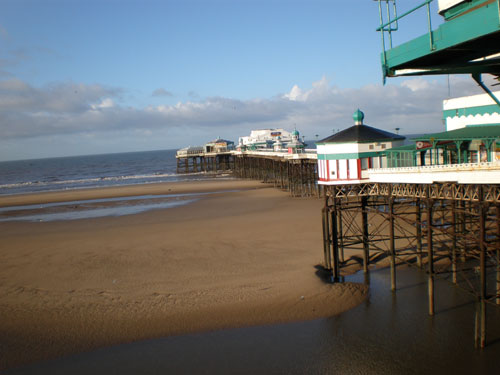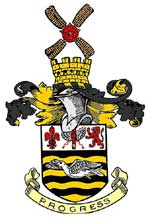
History of Blackpool
Photo of the Winter Gardens ballroom, scene of many political conferences.

A Short History of Blackpool
The name Blackpool came from a stream called Spen Dyke which carried dark water, discoloured by peat, from Marton Mere to the sea at a point that is now Manchester Square. The dyke north from Marton Mere, which was once much larger, enabled the moss to slowly dry out and become habitable.
Blackpool began its main development in the late 18th century. At that time it was an area of scattered sea-side hotels, a few residences and farms. The main places in the area were Bispham and Poulton.
In the early 19th century a landlord Henry Banks built the first holiday cottages and his son-in-law, John Cocker, later built the first shops and assembly hall.
Up to 1821 it was in the parish of Bispham Parish Church which is a Grade 2 listed building.
In 1846 the railway came to Blackpool North Station. This enabled the cotton town workers easier access and the town developed from 2,500 people in 1850 to 35,000 by 1890 and then to 145,000, larger than many cities. In the latter half of the 19th Century, 3 piers, Winter Gardens, Tower, several theatres, Pleasure Beach, trams, the Golden Mile and 3 railway lines and stations were built.
North Pier, Blackpool's first pier.

From North Station along Talbot Road to the North Pier and promenade was one of Blackpools earliest main holiday thoroughfares.
In 1876 Blackpool received its Charter of Incorporation and became a Municipal Borough. William Cocker became first mayor of the Borough.
In the early 20th century the promenade was extended north and south and in 1912 the illuminations were started. Stanley Park, the Zoo and the airport were built.
The number of visitors to Blackpool was huge acting as a focus for what was the centre of the worlds first industrial revolution and the massive population explosion that ensued. The 'Wakes Week' holidaymakers from the Lancashire and Yorkshire mills and mines and the Scottish ship, mine and steelworkers travelling mainly by rail for their annual week or fortnight holiday. Hundreds of special trains travelled into the town every weekend.
An interesting challenge was to create an infrastructure for well over 100,000 additional people to be regularly sleeping and eating in a town of 145,000.
In the late 20th and early 21st Centuries the holiday trade changed and day trippers are predominant. The infrastructure built for the boom years still exists, as do thousands of accommodation beds, but it is focussed on main buildings like the Winter Gardens and Tower with new clubs and bars. The Pleasure Beach continues major investments and the Piers to improve their facilities. The promenade has been rebuilt with headlands into the sea and new trams have been successfully introduced. Blackpool is repositioning itself for the 21st Century and with the help of Blackpool Civic Trust, since 1976, is ensuring its best is preserved.
Blackpool's Built Heritage Strategy on Blackpool Council's website
Useful Links
There is an existing body of work on the history of Blackpool. Below are links to websites containing useful information. Blackpool Civic Trust can take no responsibility for the content of these sites.
History of Blackpool A very extensive pdf document by local historian Nick Moore.
Hall Geneology History of Blackpool. Nicely written compact account.
History of Blackpool - no longer available but we're looking for it. A well written paper by Lancashire County Council
History of the Winter Gardens on the Leisure Parcs website. Interesting article, photos and schematic.
History of Blackpool Piers from the National Piers Society
History of Blackpool Illuminations
History Collection of info on one well compiled website.
Blackpool Memories Facebook page, full of old postcards.
Blackpool's Past! Facebook Group, hundreds of photos, comments on Blackpool past and present.
John Charles Robinson Blackpool Borough Architect 1920-44
We unveiled a Blue Plaque for JC Robinson in 2022 and more recently an exhibition was held at Stanley Park Visitor Centre in September 2023 to exhibit photographs taken by the New Langdale Photography Group based in Blackpool. This was arranged via the people named below, written by Elizabeth Gomm.
The Friends of Stanley Park - Blackpool are among other partners supporting the Arts Coucil England funded project celebrating the workof Mr Robinson as seen through the eyes of learning disabled photographers.
Supported by photographers Claire Walmsley Griffith, Donna Hannigan and Elizabeth Gomm and with the constant backing of the New Langdale staff, they are photographing all the remaining iconic buildings that Mr Robinson designed and the sites of those long gone.
The well attended launch today showcases some photographs taken so far and further exhibitions will be held in Blackpool Libraries, The Grundy Art Gallery and the Solaris Centre.
Buildings designed by Mr Robinson are:
Hawes Side Library, Bispham Library, Layton Toilet Block, Stanley Park Cafe, Shelters and House; Carleton Crematorium Gatehouse Chapel; the Solarium (now the Solaris Centre); Little Bispham Tram Shelter;
Stanley Park Golf Club; Blackpool Cricket Club; The shelter, Devonshire Square; Citadel 1924 Memorial Hall; Colonnades, Blackpool promenade; Blackpool Zoo; Harrowside Pool and Bridge; North Shore Lift; Stanley Buildings; St John's Market; Little Bispham Tram Shelter;
Blackpool Cricket Club; Stanley Park Golf Club; Municipal Offices; South Shore Open Air Baths; Derby Baths;
Stanley School; Collegiate Girls' School; Highfield School; Technical College Palatine Rd; Marton Library; Bispham Library; Layton Library; Highfield Library, Hawes Side Library; Squires Gate Bridge and Station and Mr Robinson's personal residence Newton Drive.
Blackpool Coat of Arms
